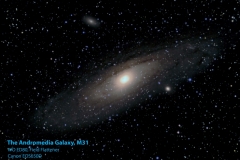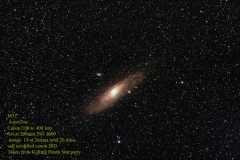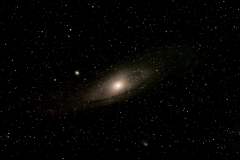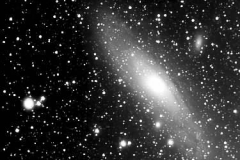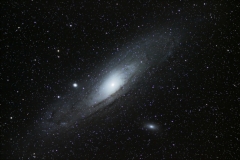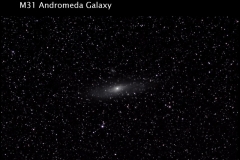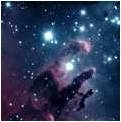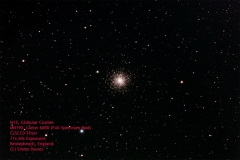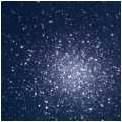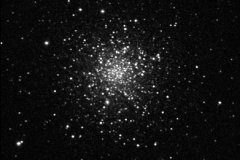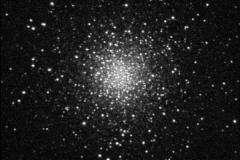[et_pb_section fb_built="1" _builder_version="4.16" global_colors_info="{}"][et_pb_row _builder_version="4.16" global_colors_info="{}"][et_pb_column type="4_4" _builder_version="4.16" custom_padding="|||" global_colors_info="{}" custom_padding__hover="|||"][et_pb_text _builder_version="4.16" global_colors_info="{}"]
The Triangulum Galaxy (also known as NGC 598) is a spiral galaxy approximately 3 million light-years away in the constellation Triangulum. The galaxy is also sometimes informally referred to as the Pinwheel Galaxy by some amateur astronomy references and in some public outreach websites. However, the SIMBAD Astronomical Database, a professional astronomy database that contains formal designations for astronomical objects, indicates that the name "Pinwheel Galaxy" is used to refer to Messier 101, and several other amateur astronomy resources and other public outreach websites also identify Messier 101 by that name. It is the third largest galaxy in the Local Group, a group of galaxies that also contains the Milky Way Galaxy and the Andromeda Galaxy, and it may be a gravitationally bound companion of the Andromeda Galaxy. The Pisces Dwarf (LGS 3), one of the small Local Group member galaxies, is possibly a satellite of Triangulum.
[/et_pb_text][et_pb_text _builder_version="4.16" global_colors_info="{}"]
[caption id="" align="aligncenter" width="746"] Image by CMHASD Members. 16" LX200. Total of 360s unfiltered[/caption]
Image by CMHASD Members. 16" LX200. Total of 360s unfiltered[/caption]
[/et_pb_text][/et_pb_column][/et_pb_row][et_pb_row _builder_version="4.16" background_size="initial" background_position="top_left" background_repeat="repeat" global_colors_info="{}"][et_pb_column type="4_4" _builder_version="4.16" custom_padding="|||" global_colors_info="{}" custom_padding__hover="|||"][et_pb_text admin_label="Simon Dawes" _builder_version="4.16" global_colors_info="{}"]
Images by Simon Dawes
[/et_pb_text][/et_pb_column][/et_pb_row][et_pb_row column_structure="1_4,1_4,1_4,1_4" _builder_version="4.16" background_size="initial" background_position="top_left" background_repeat="repeat" global_colors_info="{}"][et_pb_column type="1_4" _builder_version="4.16" custom_padding="|||" global_colors_info="{}" custom_padding__hover="|||"][et_pb_text admin_label="SD Image" _builder_version="4.16" global_colors_info="{}"]

[/et_pb_text][/et_pb_column][et_pb_column type="1_4" _builder_version="4.16" custom_padding="|||" global_colors_info="{}" custom_padding__hover="|||"][/et_pb_column][et_pb_column type="1_4" _builder_version="4.16" custom_padding="|||" global_colors_info="{}" custom_padding__hover="|||"][/et_pb_column][et_pb_column type="1_4" _builder_version="4.16" custom_padding="|||" global_colors_info="{}" custom_padding__hover="|||"][/et_pb_column][/et_pb_row][et_pb_row _builder_version="4.16" background_size="initial" background_position="top_left" background_repeat="repeat" global_colors_info="{}"][et_pb_column type="4_4" _builder_version="4.16" custom_padding="|||" global_colors_info="{}" custom_padding__hover="|||"][et_pb_text admin_label="Martin Crow" _builder_version="4.16" global_colors_info="{}"]
Images by Martin Crow
[/et_pb_text][/et_pb_column][/et_pb_row][et_pb_row column_structure="1_4,1_4,1_4,1_4" _builder_version="4.16" background_size="initial" background_position="top_left" background_repeat="repeat" global_colors_info="{}"][et_pb_column type="1_4" _builder_version="4.16" custom_padding="|||" global_colors_info="{}" custom_padding__hover="|||"][et_pb_text admin_label="MC Image" _builder_version="4.16" global_colors_info="{}"]
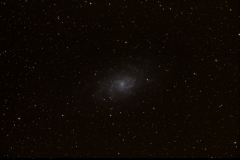
[/et_pb_text][/et_pb_column][et_pb_column type="1_4" _builder_version="4.16" custom_padding="|||" global_colors_info="{}" custom_padding__hover="|||"][/et_pb_column][et_pb_column type="1_4" _builder_version="4.16" custom_padding="|||" global_colors_info="{}" custom_padding__hover="|||"][/et_pb_column][et_pb_column type="1_4" _builder_version="4.16" custom_padding="|||" global_colors_info="{}" custom_padding__hover="|||"][/et_pb_column][/et_pb_row][et_pb_row _builder_version="4.16" background_size="initial" background_position="top_left" background_repeat="repeat" global_colors_info="{}"][et_pb_column type="4_4" _builder_version="4.16" custom_padding="|||" global_colors_info="{}" custom_padding__hover="|||"][et_pb_text admin_label="Julian Tworek" _builder_version="4.16" global_colors_info="{}"]
Images by Julian Tworek
[/et_pb_text][/et_pb_column][/et_pb_row][et_pb_row column_structure="1_4,1_4,1_4,1_4" _builder_version="4.16" background_size="initial" background_position="top_left" background_repeat="repeat" global_colors_info="{}"][et_pb_column type="1_4" _builder_version="4.16" custom_padding="|||" global_colors_info="{}" custom_padding__hover="|||"][et_pb_text admin_label="JT Image" _builder_version="4.16" global_colors_info="{}"]
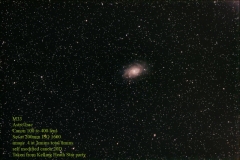
[/et_pb_text][/et_pb_column][et_pb_column type="1_4" _builder_version="4.16" custom_padding="|||" global_colors_info="{}" custom_padding__hover="|||"][/et_pb_column][et_pb_column type="1_4" _builder_version="4.16" custom_padding="|||" global_colors_info="{}" custom_padding__hover="|||"][/et_pb_column][et_pb_column type="1_4" _builder_version="4.16" custom_padding="|||" global_colors_info="{}" custom_padding__hover="|||"][/et_pb_column][/et_pb_row][et_pb_row _builder_version="4.16" background_size="initial" background_position="top_left" background_repeat="repeat" global_colors_info="{}"][et_pb_column type="4_4" _builder_version="4.16" custom_padding="|||" global_colors_info="{}" custom_padding__hover="|||"][et_pb_text admin_label="Images by Neil Webster" _builder_version="3.27.4" global_module="3174" saved_tabs="all" global_colors_info="{}"]
Images by Neil Webster
[/et_pb_text][/et_pb_column][/et_pb_row][et_pb_row column_structure="1_4,1_4,1_4,1_4" _builder_version="4.16" background_size="initial" background_position="top_left" background_repeat="repeat" global_colors_info="{}"][et_pb_column type="1_4" _builder_version="4.16" custom_padding="|||" global_colors_info="{}" custom_padding__hover="|||"][et_pb_text admin_label="AW Image" _builder_version="4.16" global_colors_info="{}"]
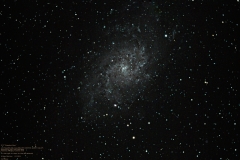
[/et_pb_text][/et_pb_column][et_pb_column type="1_4" _builder_version="4.16" custom_padding="|||" global_colors_info="{}" custom_padding__hover="|||"][/et_pb_column][et_pb_column type="1_4" _builder_version="4.16" custom_padding="|||" global_colors_info="{}" custom_padding__hover="|||"][/et_pb_column][et_pb_column type="1_4" _builder_version="4.16" custom_padding="|||" global_colors_info="{}" custom_padding__hover="|||"][/et_pb_column][/et_pb_row][et_pb_row _builder_version="4.16" background_size="initial" background_position="top_left" background_repeat="repeat" global_colors_info="{}"][et_pb_column type="4_4" _builder_version="4.16" custom_padding="|||" global_colors_info="{}" custom_padding__hover="|||"][et_pb_text admin_label="Andrew Wilson" _builder_version="4.16" global_colors_info="{}"]
Images by Andrew Wilson
[/et_pb_text][/et_pb_column][/et_pb_row][et_pb_row column_structure="1_4,1_4,1_4,1_4" _builder_version="4.16" background_size="initial" background_position="top_left" background_repeat="repeat" global_colors_info="{}"][et_pb_column type="1_4" _builder_version="4.16" custom_padding="|||" global_colors_info="{}" custom_padding__hover="|||"][et_pb_text admin_label="AW Image" _builder_version="4.16" global_colors_info="{}"]
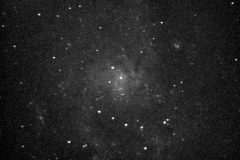
[/et_pb_text][/et_pb_column][et_pb_column type="1_4" _builder_version="4.16" custom_padding="|||" global_colors_info="{}" custom_padding__hover="|||"][/et_pb_column][et_pb_column type="1_4" _builder_version="4.16" custom_padding="|||" global_colors_info="{}" custom_padding__hover="|||"][/et_pb_column][et_pb_column type="1_4" _builder_version="4.16" custom_padding="|||" global_colors_info="{}" custom_padding__hover="|||"][/et_pb_column][/et_pb_row][et_pb_row _builder_version="4.16" _module_preset="default" global_colors_info="{}"][et_pb_column type="4_4" _builder_version="4.16" _module_preset="default" global_colors_info="{}"][et_pb_text admin_label="Images by Leigh Slomer" _builder_version="3.19.3" global_module="3217" saved_tabs="all" global_colors_info="{}"]
Images by Leigh Slomer
[/et_pb_text][et_pb_text _builder_version="4.16" _module_preset="default" global_colors_info="{}"]
[caption id="" align="alignnone" width="240"]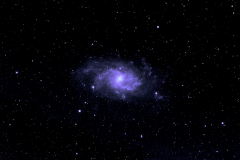 Image by Leigh Slomer Messier 33 The Triangulum Galaxy is a Galaxy in the constellation of Triangulum. This was a quick capture, taken amongst the fireworks in the run up to Guy Fawkes Night.[/caption]
Image by Leigh Slomer Messier 33 The Triangulum Galaxy is a Galaxy in the constellation of Triangulum. This was a quick capture, taken amongst the fireworks in the run up to Guy Fawkes Night.[/caption]
[/et_pb_text][/et_pb_column][/et_pb_row][et_pb_row _builder_version="4.24.0" _module_preset="default" global_colors_info="{}"][et_pb_column type="4_4" _builder_version="4.24.0" _module_preset="default" global_colors_info="{}"][et_pb_text admin_label="Images by Keith Rickard" _builder_version="3.16" global_module="2596" saved_tabs="all" global_colors_info="{}"]
Images by Keith Rickard
[/et_pb_text][/et_pb_column][/et_pb_row][et_pb_row column_structure="1_4,1_4,1_4,1_4" _builder_version="4.24.0" _module_preset="default" global_colors_info="{}"][et_pb_column type="1_4" _builder_version="4.24.0" _module_preset="default" global_colors_info="{}"][et_pb_text _builder_version="4.24.0" _module_preset="default" hover_enabled="0" global_colors_info="{}" sticky_enabled="0"]

[/et_pb_text][/et_pb_column][et_pb_column type="1_4" _builder_version="4.24.0" _module_preset="default" global_colors_info="{}"][/et_pb_column][et_pb_column type="1_4" _builder_version="4.24.0" _module_preset="default" global_colors_info="{}"][/et_pb_column][et_pb_column type="1_4" _builder_version="4.24.0" _module_preset="default" global_colors_info="{}"][/et_pb_column][/et_pb_row][/et_pb_section]


 Image by CMHASD Members. 16" LX200. Total of 360s unfiltered[/caption]
Image by CMHASD Members. 16" LX200. Total of 360s unfiltered[/caption]






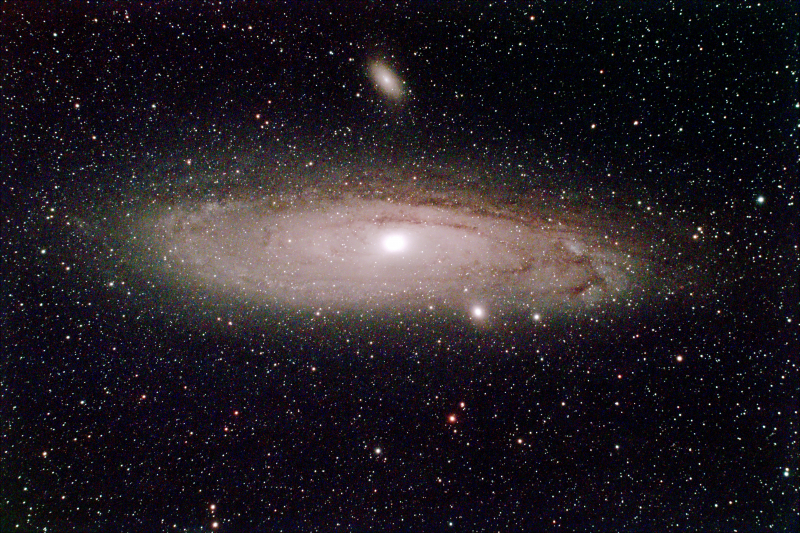 Image by Leigh Slomer Stacked from 30 x 2 minute light frames at ISO 1600 with 20 dark and 64 flat frames. Taken using a Skywatcher Evostar 72ed Pro telescope, a Canon Eos 250d astro modified dslr and a CLS filter. Mounted on a Skywatcher HEQ5 Pro mount, unguided. Stacked with Deep Sky Stacker and processed in GIMP.[/caption]
Image by Leigh Slomer Stacked from 30 x 2 minute light frames at ISO 1600 with 20 dark and 64 flat frames. Taken using a Skywatcher Evostar 72ed Pro telescope, a Canon Eos 250d astro modified dslr and a CLS filter. Mounted on a Skywatcher HEQ5 Pro mount, unguided. Stacked with Deep Sky Stacker and processed in GIMP.[/caption]